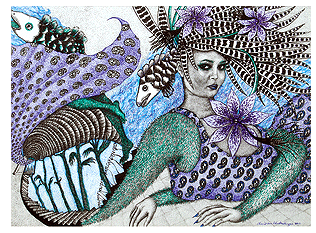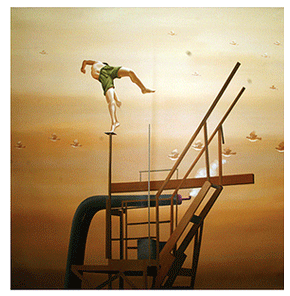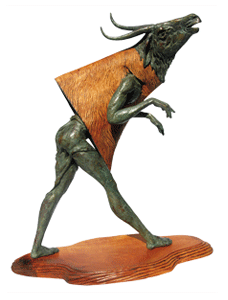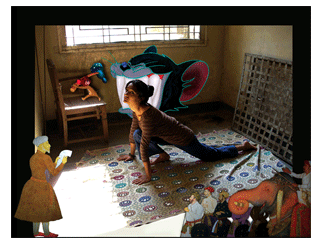- Prelude
- Editorial
- ...Where ever I stumble, let painting lie before me....
- ...Colour guides in its own direction...
- Abstract Art: Popular Myths and History
- Abstract Rhetoric:
- Ram Kumar: A transition from figurative to abstract
- I walk the line
- Exploring a twilight zone
- Articulating the Abstract voice from Madhya Pradesh
- Perception of Abstract in forms
- Confronting Cultures: The Dialectic of Abstraction in Bengal Art
- K.C.S. Paniker and his Words and Symbols
- Dialectics of Abstract Art and Its Indigenous Identity
- Between Ambivalence and Criticism: Why Abstraction?
- Notations and Rhythm in Space: Sushen Ghosh
- Victorian Era: Eclectic Furniture
- Patek Philippe : an overview
- The “Theme Pandals” of Durga Pujo: An Unexplored Discourse
- Musings on Music
- Butterflies in the stomach… still
- Contemporary Art Market Report 2009-10
- Artist Index and Statistics
- Auction Reports
- Recent works of Pavan kumar D. - In the Journey of Learning things
- Narrating “with a pinch of salt” Paintings of K.P.Reji
- Reclaiming an artist of true calibre
- Musings from Chennai
- An Annual Homage..
- Art Events Kolkata: September-October 2010
- Mumbai Art Sighting
- Art Bengaluru
- Unveiling the next in line
- Preview
- In the News
- Sotheby’s : Important Watches Hong Kong
ART news & views
Preview
Volume: 3 Issue No: 10 Month: 11 Year: 2010
Raqs Media Collective
Mumbai
The Capital of Accumulation
October 20 to November 20, 2010
As a counterpoint to Rosa Luxemburg's trenchant critique of global political economy, “The Accumulation of Capital”, Raqs Media Collective creates a two screen video installation called “the Capital of Accumulation” which obliquely narrativises the relationship between metropolises and the world. The installation is a diptych presenting an enticing dream-like landscape straddling Warsaw, Berlin and Mumbai. Elements of natural history and detective journal, forensic analysis and cosmopolitan urban investigation are creatively fused together here to initiate a philosophical dialogue on the renewability of the time we belong to. The narrative combines stories of what could have happened in 20th century Berlin, Mumbai and Warsaw in economic, political and social spheres, but in actuality it turns out to be a story of the 21st century for all its cities.
The narrative combines stories of what could have happened in 20th century Berlin, Mumbai and Warsaw in economic, political and social spheres, but in actuality it turns out to be a story of the 21st century for all its cities.
These are a series of photographs titled “The Perpetual Recall of the Penultimate Afternoon” which are an itinerary in the footsteps of Rosa Luxemberg's last days in Berlin, recording different addresses where Rosa Luxemburg lived in the days before she was assassinated, with a detour into the yard of the former Rosa Luxemburg Electric Light Bulb Factory in Warsaw. Apart from these, the exhibition also consists of a light installation titled “REVOLTAGE”, and another sculptural object titled “Rules to be Invented” which is a chess-board that scales peaks. In the latter pieces, knights and dices, climb up and down a terrain as uneven as history inducing the audience to invent the rules of travelling for themselves.
Gandhara Art Gallery
Kolkata
Visual Alphabets
October 24 to November 4
There are moments when the artist is the most intimate with himself. His drawings are perhaps the most faithful and automatic reflections of those rare moments. Like seismograph, they record even the slightest tremors in the artist's psyche, and express them in the purest possible forms, varying in intensity and tonality. But, like language, a drawing does also belong to a symbolic order, and as such, a reading of drawings turns out to be an examination of the ways in  which an individual makes adjustments between his visual symbolic order and various expressive modalities available to him.
which an individual makes adjustments between his visual symbolic order and various expressive modalities available to him.
Visual Alphabets, an exhibition on drawings inaugurating at the Gandhara Art Gallery on 24th October, looks at the processes of such creative adjustments which may well be termed the alphabet of visual construction. Works that indicate the journey from the verbal to the visual, and the reverse, will also be categorically traced. This exhibition shall showcase ink works by twelve artists Adip Dutta, Chhatrapati Dutta, Chandrima Bhattacharya, Debnath Basu, Debashis Manna, Manjari Chakravati, Mallesi HV, Reji Arakkal Nantu Behari Das, Kazi Nasir, Sambaran Das and Sunil Padwal all of whom through a conscious mnemonic exercise have created individual visual codes which seek to transform everyday banality into an aesthetic experience. The exhibition attempts to present not merely stylistic visual traits but an overarching visual vocabulary which makes creation possible.
Aicon Gallery
New York
Figure/Landscape - Part One
October 28 to November 13
Throughout the course modern Indian art, the dual themes of landscape and the figure, and the interaction between the two, have occupied Indian artists' imagination.  This is where they are significantly different from the artists working in the Western modernist tradition. Unlike their European counterparts, Indian artists like M. F. Husain and F. N. Souza, among others, abstained from pure abstaction, and remained committed in their work to figurative references to both landscape and the individual. This imparts a unique cultural identity to their ongoing modernist experiments.
This is where they are significantly different from the artists working in the Western modernist tradition. Unlike their European counterparts, Indian artists like M. F. Husain and F. N. Souza, among others, abstained from pure abstaction, and remained committed in their work to figurative references to both landscape and the individual. This imparts a unique cultural identity to their ongoing modernist experiments.
This two-part exhibition, to be staged in New York and London, aims to explore this prevalence of the figurative in modern Indian art through the presentation of works from the 20th century, and also some from the current century. Landscape, the figure and the interplay between them are the pivotal points of the project. Some works here appear almost as pure, albeit abstracted, landscapes while others are nearly entirely figurative. Yet a number of works show the figure dissolving into, or functioning almost as a constituent part of, the landscape, bringing to light the complex and interdependent relationships that can arise between these two recurring motifs of Indian modernism. The artists in the show include F. N. Souza, M. F. Husain, Jagdish Swaminathan, George Keyt, Jehangir Sabavala, Anjolie Ela Menon, Sudhir Patwardhan and Shyamal Dutta-Ray amongst others.
Tamarind Art Council
New York
Solo exhibition of Pratul Dash
November 01 to December 04
The latest video by Pratul Dash, "The Story of a Landscape" (2010), in the gallery's main hall is an experimental fusion of live action and animation with digitally stitched landscape depicting two of the artist's oil paintings named, "Conch Blower" and "Man with a Camera".  The work will extend and amplify the conscientious nature of Dash's recent work, demonstrating an evolution in Dash's practice, with elements not often seen in his past work such as the use of CG animation. The film opens with picturesque landscape, alluding to a crisscross of time and space. When idyllic representations are subverted by the artist's perception, the landscape becomes a site of haunted desolation.
The work will extend and amplify the conscientious nature of Dash's recent work, demonstrating an evolution in Dash's practice, with elements not often seen in his past work such as the use of CG animation. The film opens with picturesque landscape, alluding to a crisscross of time and space. When idyllic representations are subverted by the artist's perception, the landscape becomes a site of haunted desolation.
As an artist who was born in a small town in India and later migrated to a bustling metropolis in his adult life, Dash's art is very sensitive to his environment, reflecting the socio-cultural ethos he inhabits and works from. "Life of a Double", a disturbing dual projection, is a product of artist's endless quest to locate the urban and the existence of the human beings in the urban locale.
Aakriti Art Gallery
Kolkata
Projection of Disjointed Times : Sculptures by Akhil Chandra Das
November 15 to December 11
As a sculptor Akhil Chandra Das has always believed in using limited means to send complex signals, lending a well constructed look to his sculptures. While Akhil's work has always taken a swipe at the cultural decadence, hypocrisy, capitalism and erosion of  values which he evokes through surreal and mythological images with a sense of the absurd, disdain, wit and sarcasm, one gets the feeling that he is inescapably obsessed with illusionary aspects of his images figured out through wood and bronze. The works are structured around the interactivity of disparate body parts, projecting disunities and interpersonal separations as symptomatic of today's unstable times, and also of disintegrations of history.
values which he evokes through surreal and mythological images with a sense of the absurd, disdain, wit and sarcasm, one gets the feeling that he is inescapably obsessed with illusionary aspects of his images figured out through wood and bronze. The works are structured around the interactivity of disparate body parts, projecting disunities and interpersonal separations as symptomatic of today's unstable times, and also of disintegrations of history.
The work in this exhibition operates through humour(or sarcasm) and by stylistic devices such as double entendre, masked humans underneath the mask of a beast. Akhil has cast himself as a goofy, ludicrous and thoroughly enjoyable totem with a self-deprecating smile and closed eyes who have achieved some state of bliss. a kind of pun on the vacuity of present living and consumerism. There is something quite surreal about these sculptural works, both in their juxtaposition of quirky, absurd objects and in their representations of a hypocritical society whose desire for objects.
Emami Chisel Art
Kolkata
Story of the Multiples
November 23 to December 8
“Art”, as Wittgenstein therefore surmised, “is a concept with open boundaries.” The possibilities of digital art began to be explored in right earnest from the middle of the last century, in a bid to interrogate patterns and practices that began to get increasingly closed and stifling.
 With the infiltration of the television in Indian homes from around the 80's of the 20th century, the popularity of this visual medium began to soar. Artists were inspired to explore this hitherto less travelled path, and traverse it in ways that could enable them to find newer idioms and languages of expression like installation, sound installation, video installation etc. The defining feature of video art became its specific content and the intent of the artist that stood apart from other modes of videography. Digitally manipulated photography etc have also played its part in elevating the humble camera to a heightened zone of creativity.
With the infiltration of the television in Indian homes from around the 80's of the 20th century, the popularity of this visual medium began to soar. Artists were inspired to explore this hitherto less travelled path, and traverse it in ways that could enable them to find newer idioms and languages of expression like installation, sound installation, video installation etc. The defining feature of video art became its specific content and the intent of the artist that stood apart from other modes of videography. Digitally manipulated photography etc have also played its part in elevating the humble camera to a heightened zone of creativity.
The exhibition will focus on the following categories:
Space (movement), Society (Politics, religion), Language (Communication) and History (Time). Some of the participating artists are: Chhatrapati Dutta, Sumedh Rajendran, Prasad Raghavan, Tushar Joag, Anuradha Pathak, Baptist Coelho among others.